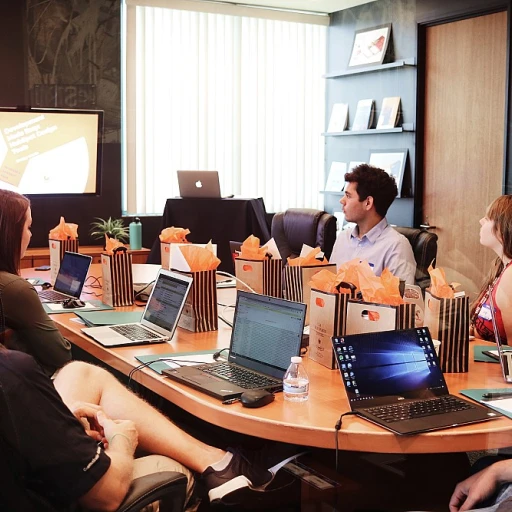
Understanding Talent Mobility
Demystifying Talent Mobility
The concept of talent mobility has become increasingly significant in today's competitive business environment. It refers to the strategic process of moving employees across roles, departments, and even countries within an organization to meet evolving business needs. This approach not only aids in closing skills gaps but also enhances employee engagement and development. In a well-executed mobility program, businesses can leverage their existing workforce to fill internal roles effectively, promoting internal talent development while minimizing the costs of hiring externally. Companies that adopt a robust talent mobility strategy are often seen as attractive employers, which helps in retaining top talent. However, implementing an internal mobility strategy is not without its challenges. Creating a marketplace where talent can be seamlessly transitioned involves a cultural shift within the organization, as well as a focus on learning and development. Organizations aiming to cultivate an effective talent mobility program will need to consider not only the potential career paths for their employees but also the skills required for future roles. This strategic focus on employee development ensures that businesses are prepared for long-term success, while also offering employees new career opportunities that align with their aspirations. For insights on how reskilling can unlock these opportunities, explore this in-depth resource. Ultimately, talent mobility is more than just moving employees around; it's about creating a workforce that can adapt to the ever-evolving business landscape.The Role of Reskilling in Talent Mobility
The Integral Role of Reskilling in Shaping Talent Mobility
In today's dynamic workplace environment, organizations are increasingly focusing on reskilling as a key strategy to enhance talent mobility. This approach not only addresses current skill gaps within the workforce but also prepares employees for future roles, fostering a more adaptable and resilient workforce. In this context, reskilling becomes an essential component of any successful mobility strategy.
Effective talent mobility relies heavily on an organization's ability to identify and nurture internal talent. By investing in the reskilling of employees, companies can create a talent marketplace where internal moves are encouraged, and new skills are developed, ultimately benefiting both the employee and the business. This internal mobility helps in maintaining a competitive edge and supports long term organizational growth.
One of the critical aspects of reskilling is aligning employee development programs with the company's strategic goals. This ensures that the skills being developed are directly relevant to the evolving needs of the organization, facilitating career development and creating new opportunities for employees within various roles. Additionally, reskilling initiatives contribute to employee engagement by showing a commitment to their professional growth and career paths.
Reskilling also plays a pivotal role in talent management, offering a structured pathway for employees to transition into new and in-demand roles within the company. This not only supports an organization's global mobility efforts but also helps in retaining top talent by providing them with opportunities for personal and professional development. In essence, a well-designed reskilling program supports the overarching talent mobility strategy by enabling a fluid movement of employees across different roles and departments.
Identifying Skills for the Future
Navigating Future Skills Needs
As businesses and organizations grapple with rapid technological changes and evolving market demands, identifying the skills of the future becomes crucial. This process is not just about anticipating what skills will be in demand, but also about strategically aligning current workforce capabilities with future needs. This alignment will ensure effective talent mobility within the company.
To begin, organizations must conduct a thorough assessment of their current workforce's skills. This helps in identifying skills gaps that might hinder internal mobility and impede career development opportunities for employees. Using data-driven insights, companies can pinpoint specific areas where reskilling efforts should be focused.
In addition, leveraging insights from the talent marketplace can help organizations understand broader industry trends. This understanding will aid in aligning internal talent development strategies with the external environment, thus ensuring that employees are equipped with the skills necessary for future roles.
Utilizing Workforce Analytics
Workforce analytics is a powerful tool for identifying future skill requirements. By analyzing data on current skillsets and matching them with predicted future business needs, companies can better strategize their reskilling programs. This will facilitate smoother internal moves and bolster employee engagement by providing clear career paths.
It's important for organizations to foster a culture of continuous learning and development. Encouraging employees to embrace lifelong learning will not only help bridge skill gaps but also build resilience, ensuring that they remain competitive in a dynamic job market.
- Ensure the alignment of learning and development with business strategy to support talent management.
- Design and implement effective talent mobility programs that emphasize skill mastery and career progression.
- Create mobility strategies that enhance employee engagement and retention.
Organizations adopting these best practices will effectively navigate the path to talent mobility, ensuring that top talent within the company is quickly and efficiently reallocated to where they can deliver the most impact. For a deeper insight into aligning skills for future roles, consider exploring this comprehensive guide on talent mobility.
Overcoming Challenges in Reskilling
Overcoming Obstacles to Skills Development
The journey to effective talent mobility within an organization is fraught with challenges, especially when it comes to reskilling employees. In order to foster a dynamic workforce capable of navigating changing business landscapes, it's essential to tackle these obstacles head-on.
One primary hurdle is identifying the skills gaps that exist within the company. Organizations need a comprehensive strategy to assess current capabilities and future requirements, ensuring that efforts are directed towards areas that will provide the most tangible benefits. A robust talent management system or a marketplace can greatly aid in this effort by providing insights into current skill sets and predicting future needs.
Additionally, resistance to change can be a significant barrier. Employees may be hesitant to embrace new learning opportunities, fearing that stepping into unfamiliar roles could be risky for their career paths. Here, a culture of support and encouragement is crucial. Companies can design career development programs that clearly illustrate the benefits of internal mobility and long-term career growth, helping employees feel more secure in pursuing internal moves.
Logistical issues such as time constraints and resource limitations can also impede the reskilling process. It is important for organizations to allocate the necessary resources and create flexible learning development schedules that accommodate employees' current workloads. Adopting best practices in learning delivery can enhance employee engagement and ensure effective talent development.
Moreover, having a well-thought-out mobility strategy ensures that the skills acquired through reskilling are effectively utilized. Mobility programs should integrate with the company's overall strategy for internal talent, opening up new roles and career pathways for reskilled individuals. This approach not only addresses skills gaps but also enhances business performance by employing top talent in positions where they can thrive.













